Development and Evaluation of Newly Designed Coaxial Cylindrical Plasma Reactor with Liquid Flow Control and Post-Discharge Reactions for Water Treatment
Abstract
:1. Introduction
2. Materials and Methods
- 1.
- Turned on the pulsed power supply, and generated the pulsed streamer discharges with a certain repetition frequency for .
- 2.
- Turned off the pulsed power supply and kept the streamers off for .
- 3.
- Took the solution sample and measured its absorbance at 610 nm.
- 4.
- Repeated Processes 1–3, which we call one cycle, until the decolorization rate became more than 95%.
3. Results and Discussion
3.1. Flow and Discharge Characteristics
3.2. Measurement of OH Radicals in Solution with Chemical Probe Method Using NaTA
3.3. Decolorization Characteristics
- All the OH radicals shown in Figure 7 were used to decompose the indigo carmine.
- The reaction between one OH radical and one indigo carmine molecule always led to the decolorization.
4. Conclusions
Author Contributions
Funding
Institutional Review Board Statement
Informed Consent Statement
Data Availability Statement
Conflicts of Interest
References
- Locke, B.R. Environmental applications of electrical discharge plasma with liquid water: A mini review. Int. J. Plasma Environ. Sci. Technol. 2012, 6, 194–203. [Google Scholar]
- Kong, M.G.; Kroesen, G.; Morfill, G.; Nosenko, T.; Shimizu, T.; Van Dijk, J.; Zimmermann, J.L. Plasma medicine: An introductory review. New J. Phys. 2009, 11, 115012. [Google Scholar] [CrossRef]
- Šimek, M.; Homola, T. Plasma-assisted agriculture: History, presence, and prospects-a review. Eur. Phys. J. D 2021, 75, 210. [Google Scholar] [CrossRef]
- Vasilev, M.; Conlon, P.; Bohl, D.; Thagard, S.M. The Effect of Discharge Frequency of a Gas–Liquid Plasma Reactor on Bulk Liquid Transport and Removal of Organic Contaminants. Plasma Chem. Plasma Process. 2022, 1–25. [Google Scholar] [CrossRef]
- Griseti, E.; Merbahi, N.; Golzio, M. Anti-cancer potential of two plasma-activated liquids: Implication of long-lived reactive oxygen and nitrogen species. Cancers 2020, 12, 721. [Google Scholar] [CrossRef] [PubMed] [Green Version]
- Nishimura, J.; Takahashi, K.; Takaki, K.; Koide, S.; Suga, M.; Orikasa, T.; Teramoto, Y.; Uchino, T. Removal of ethylene and by-products using dielectric barrier discharge with Ag nanoparticle-loaded zeolite for keeping freshness of fruits and vegetables. Trans. Mater. Res. Soc. Jpn. 2016, 41, 41–45. [Google Scholar] [CrossRef] [Green Version]
- Bruggeman, P.J.; Kushner, M.J.; Locke, B.R.; Gardeniers, J.G.E.; Graham, W.G.; Graves, D.B.; Hofman-Caris, R.; Maric, D.; Reid, J.P.; Ceriani, E.; et al. Plasma–liquid interactions: A review and roadmap. Plasma Sources Sci. Technol. 2016, 25, 53002. [Google Scholar] [CrossRef]
- Itikawa, Y.; Nigel, M. Cross Sections for Electron Collisions with Water Molecules. J. Phys. Chem. Ref. Data 2005, 34, 1–22. [Google Scholar] [CrossRef]
- Tomita, K.; Inada, Y.; Komuro, A.; Zhang, X.; Uchino, K.; Ono, R. Measurement of electron velocity distribution function in a pulsed positive streamer discharge in atmospheric-pressure air. J. Phys. D Appl. Phys. 2019, 53, 08LT01. [Google Scholar] [CrossRef]
- Malik, M.A. Water purification by plasmas: Which reactors are most energy efficient? Plasma Chem. Plasma Process. 2010, 30, 21–31. [Google Scholar] [CrossRef]
- Minamitani, Y.; Shoji, S.; Ohba, Y.; Higashiyama, Y. Decomposition of dye in water solution by pulsed power discharge in a water droplet spray. IEEE Trans. Plasma Sci. 2008, 36, 2586–2591. [Google Scholar] [CrossRef]
- Yano, T.; Uchiyama, I.; Fukawa, F.; Teranishi, K.; Shimomura, N. Water treatment by atmospheric discharge produced with nanosecond pulsed power. In Proceedings of the 2008 IEEE International Power Modulators and High-Voltage Conference, Las Vegas, NV, USA, 27–31 May 2008; pp. 80–83. [Google Scholar]
- Tanaka, H.; Mizuno, M.; Ishikawa, K.; Nakamura, K.; Kajiyama, H.; Kano, H.; Kikkawa, F.; Hori, M. Plasma-activated medium selectively kills glioblastoma brain tumor cells by down-regulating a survival signaling molecule, AKT kinase. Plasma Med. 2011, 1, 265–277. [Google Scholar] [CrossRef] [Green Version]
- Ikawa, S.; Kitano, K.; Hamaguchi, S. Effects of pH on bacterial inactivation in aqueous solutions due to low-temperature atmospheric pressure plasma application. Plasma Process. Polym. 2010, 7, 33–42. [Google Scholar] [CrossRef]
- Tani, A.; Ono, Y.; Fukui, S.; Ikawa, S.; Kitano, K. Free radicals induced in aqueous solution by non-contact atmospheric-pressure cold plasma. Appl. Phys. Lett. 2012, 100, 254103. [Google Scholar] [CrossRef]
- Jean-M, F.; Xochitl, D.B.; Mika, S. Towards reliable quantification of hydroxyl radicals in the Fenton reaction using chemical probes. RSC Adv. 2018, 8, 5321–5330. [Google Scholar]
- Mark, G.; Tauber, A.; Laupert, R.; Schuchmann, H.P.; Schulz, D.; Mues, A.; von Sonntag, C. OH-radical formation by ultrasound in aqueous solution–Part II: Terephthalate and Fricke dosimetry and the influence of various conditions on the sonolytic yield. Ultrason. Sonochem. 1998, 5, 41–52. [Google Scholar] [CrossRef]
- Kanazawa, S.; Kawano, H.; Watanabe, S.; Furuki, T.; Akamine, S.; Ichiki, R.; Ohkubo, T.; Kocik, M.; Mizeraczyk, J. Observation of OH radicals produced by pulsed discharges on the surface of a liquid. Plasma Sources Sci. Technol. 2011, 20, 34010. [Google Scholar] [CrossRef]
- Coanda, H. Propulseur. France Patent 416541, 22 October 1910. [Google Scholar]
- Coanda, H. Propeller. U.S. Patent 1,104,963, 28 July 1914. [Google Scholar]
- Coanda, H. Device for Deflecting a Stream of Elastic Fluid Projected into an Elastic Fluid. U.S. Patent 2,052,869, 1 September 1936. [Google Scholar]
- Reba, I. Applications of the Coanda effect. Sci. Am. 1966, 214, 84–93. [Google Scholar] [CrossRef]
- Suematsu Electronics. MPC Series|High Voltage, High Power, High Repetition Rate. Available online: http://www.suematsu-el.jp/en/products/02.php (accessed on 22 May 2022).
- Matthews, R.W. The radiation chemistry of the terephthalate dosimeter. Radiat. Res. 1980, 83, 27–41. [Google Scholar] [CrossRef]
- Fang, X.; Mark, G.; von Sonntag, C. OH radical formation by ultrasound in aqueous solutions Part I: The chemistry underlying the terephthalate dosimeter. Ultrason. Sonochem. 1996, 3, 57–63. [Google Scholar] [CrossRef]
- Ono, R.; Oda, T. Formation and structure of primary and secondary streamers in positive pulsed corona discharge-effect of oxygen concentration and applied voltage. J. Phys. D Appl. Phys. 2003, 36, 1952. [Google Scholar] [CrossRef]
- Namihira, T.; Wang, D.; Katsuki, S.; Hackam, R.; Akiyama, H. Propagation velocity of pulsed streamer discharges in atmospheric air. IEEE Trans. Plasma Sci. 2003, 31, 1091–1094. [Google Scholar] [CrossRef] [Green Version]
- Shiraki, D.; Ishibashi, N.; Takeuchi, N. Quantitative Estimation of OH Radicals Reacting in Liquid Using a Chemical Probe for Plasma in Contact With Liquid. IEEE Trans. Plasma Sci. 2016, 44, 3158–3163. [Google Scholar] [CrossRef]
- Kanazawa, S.; Furuki, T.; Nakaji, T.; Akamine, S.; Ichiki, R. Application of chemical dosimetry to hydroxyl radical measurement during underwater discharge. In Journal of Physics: Conference Series, Proceedings of the 7th International Conference on Applied Electrostatics (ICAES-2012), Dalian, China, 17–19 September 2012; IOP Publishing: Bristol, UK, 2013; Volume 418, p. 12102. [Google Scholar]
- Ikawa, S.; Tani, A.; Nakashima, Y.; Kitano, K. Physicochemical properties of bactericidal plasma-treated water. J. Phys. D. Appl. Phys. 2016, 49, 425401. [Google Scholar] [CrossRef]
- Lukes, P.; Dolezalova, E.; Sisrova, I.; Clupek, M. Aqueous-phase chemistry and bactericidal effects from an air discharge plasma in contact with water: Evidence for the formation of peroxynitrite through a pseudo-second-order post-discharge reaction of H2O2 and HNO2. Plasma Sources Sci. Technol. 2014, 23, 15019. [Google Scholar] [CrossRef]
- Kettle, A.J.; Clark, B.M.; Winterbourn, C.C. Superoxide converts indigo carmine to isatin sulfonic acid: Implications for the hypothesis that neutrophils produce ozone. J. Biol. Chem. 2004, 279, 18521–18525. [Google Scholar] [CrossRef] [Green Version]
- Flox, C.; Ammar, S.; Arias, C.; Brillas, E.; Vargas-Zavala, A.V.; Abdelhedi, R. Electro-Fenton and photoelectro-Fenton degradation of indigo carmine in acidic aqueous medium. Appl. Catal. B Environ. 2006, 67, 93–104. [Google Scholar] [CrossRef]
- Crema, A.P.S.; Borges, L.D.P.; Micke, G.A.; Debacher, N.A. Degradation of indigo carmine in water induced by non-thermal plasma, ozone and hydrogen peroxide: A comparative study and by-product identification. Chemosphere 2020, 244, 125502. [Google Scholar] [CrossRef]
- Lukes, P.; Clupek, M.; Babicky, V.; Sunka, P. Ultraviolet radiation from the pulsed corona discharge in water. Plasma Sources Sci. Technol. 2008, 17, 24012. [Google Scholar] [CrossRef]
- Tian, W.; Kushner, M.J. Atmospheric pressure dielectric barrier discharges interacting with liquid covered tissue. J. Phys. D Appl. Phys. 2014, 47, 165201. [Google Scholar] [CrossRef] [Green Version]


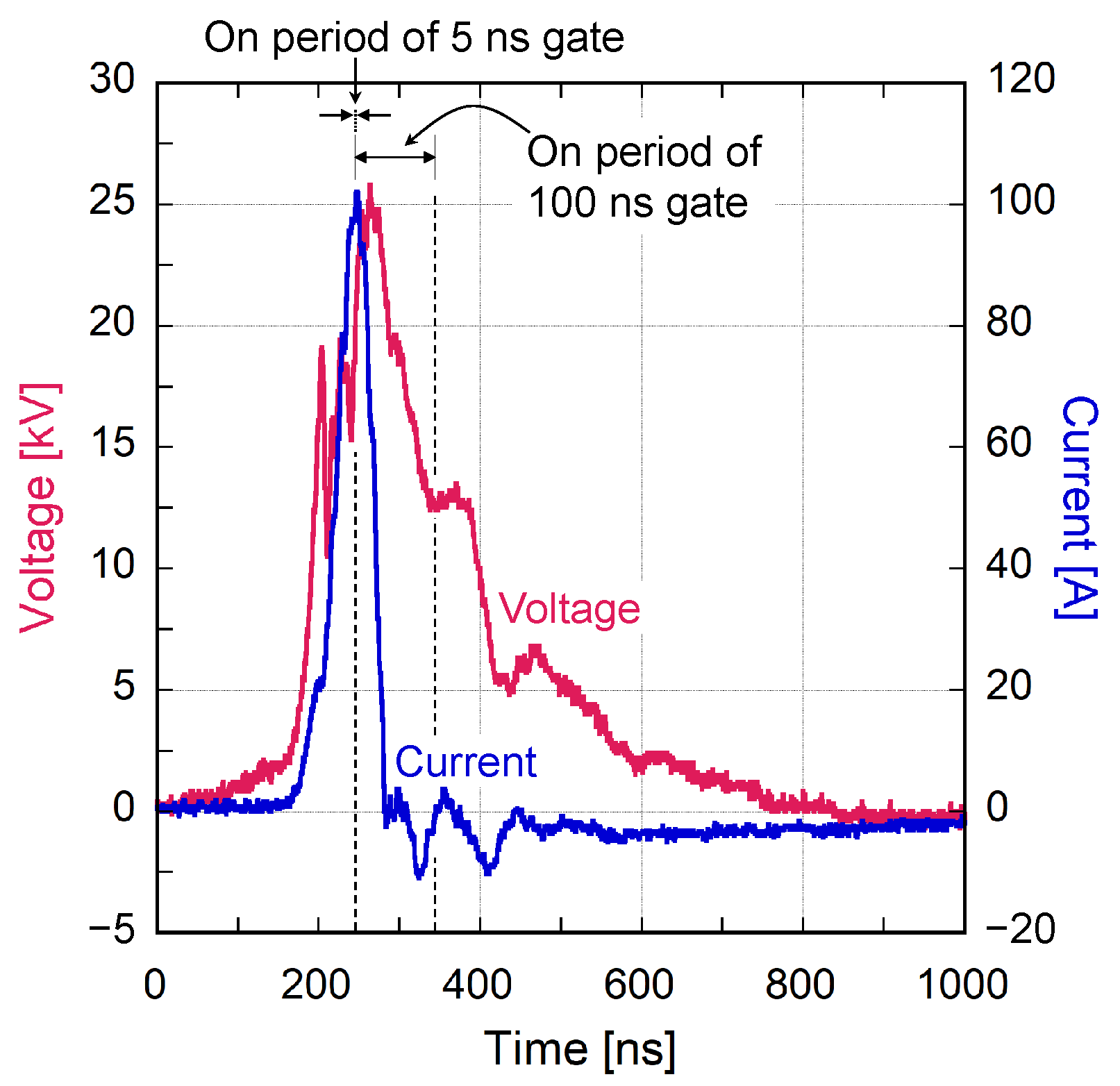

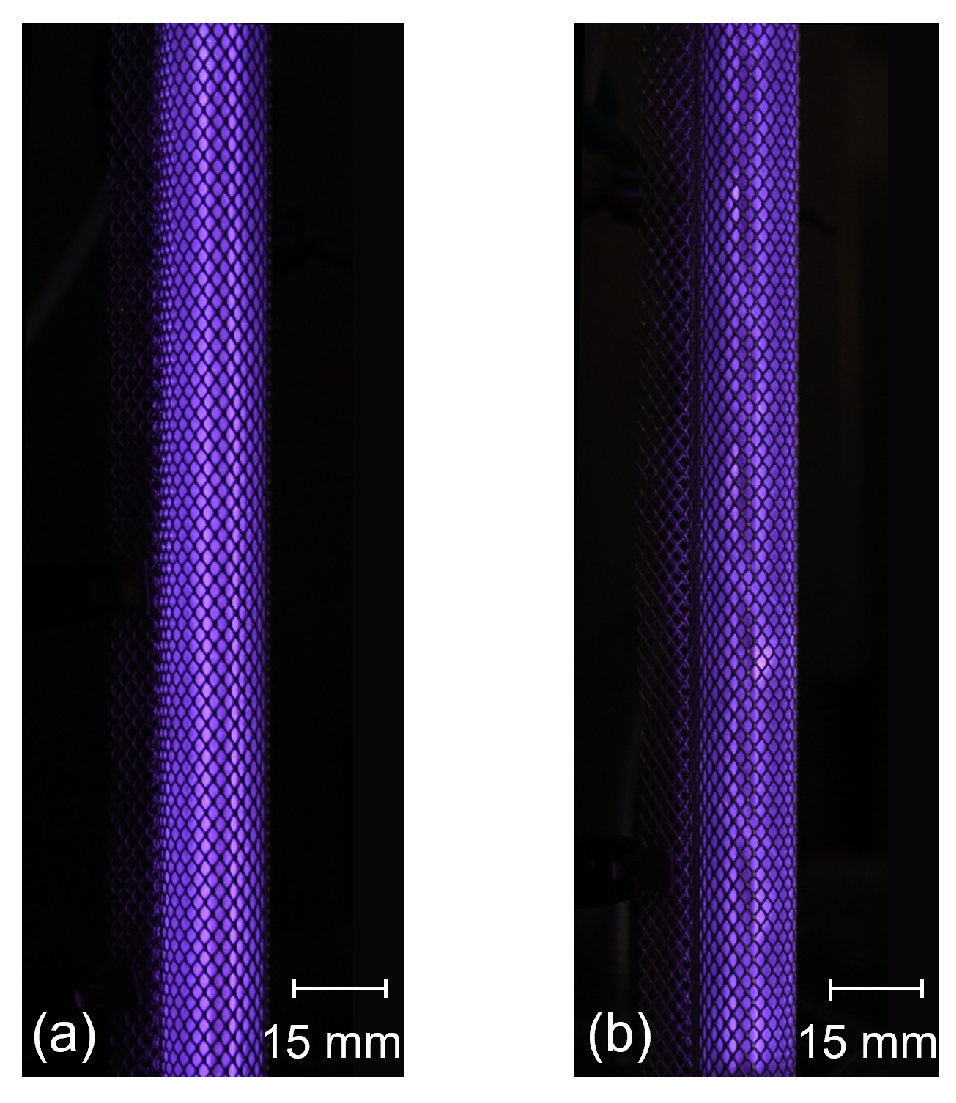

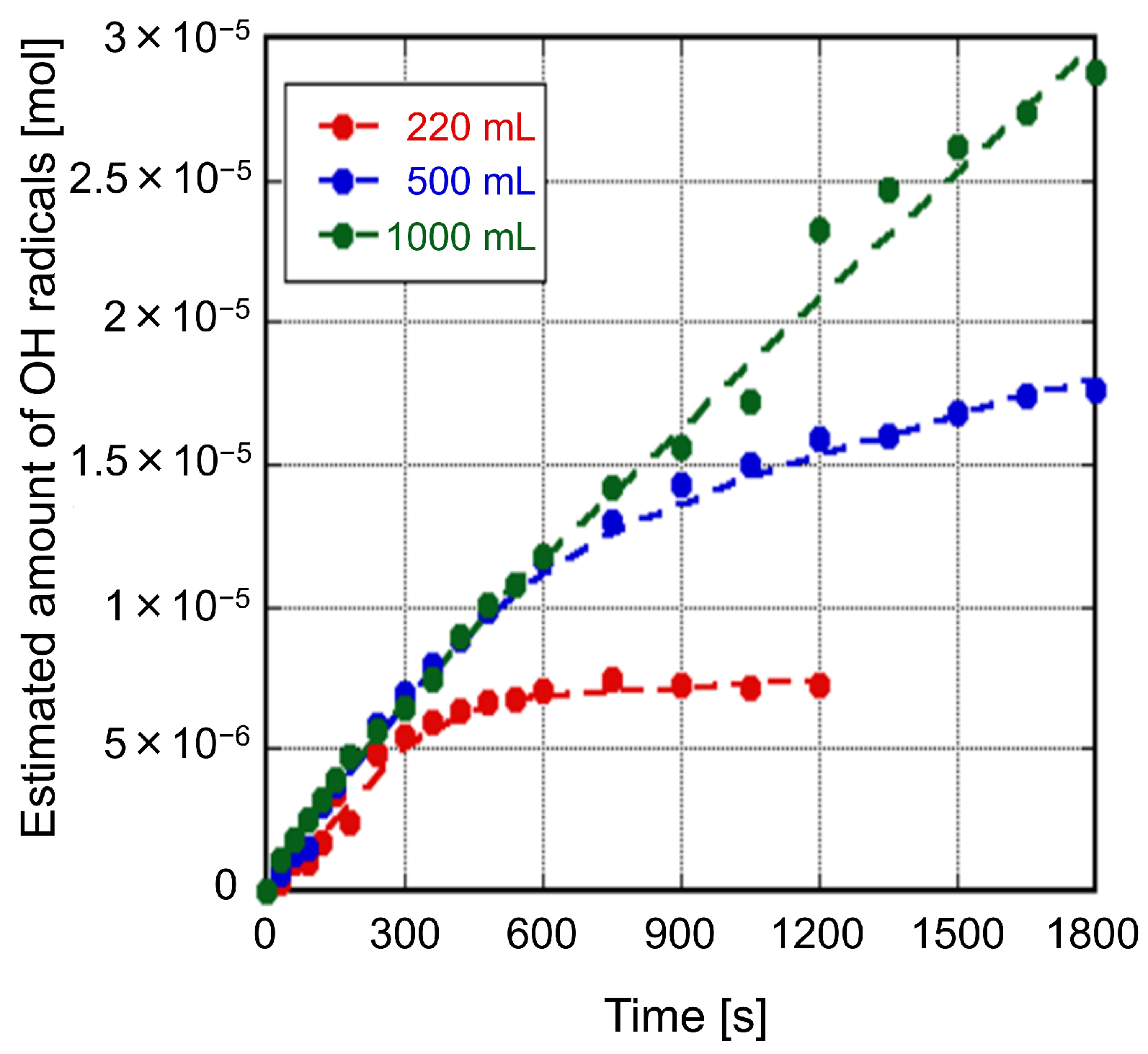

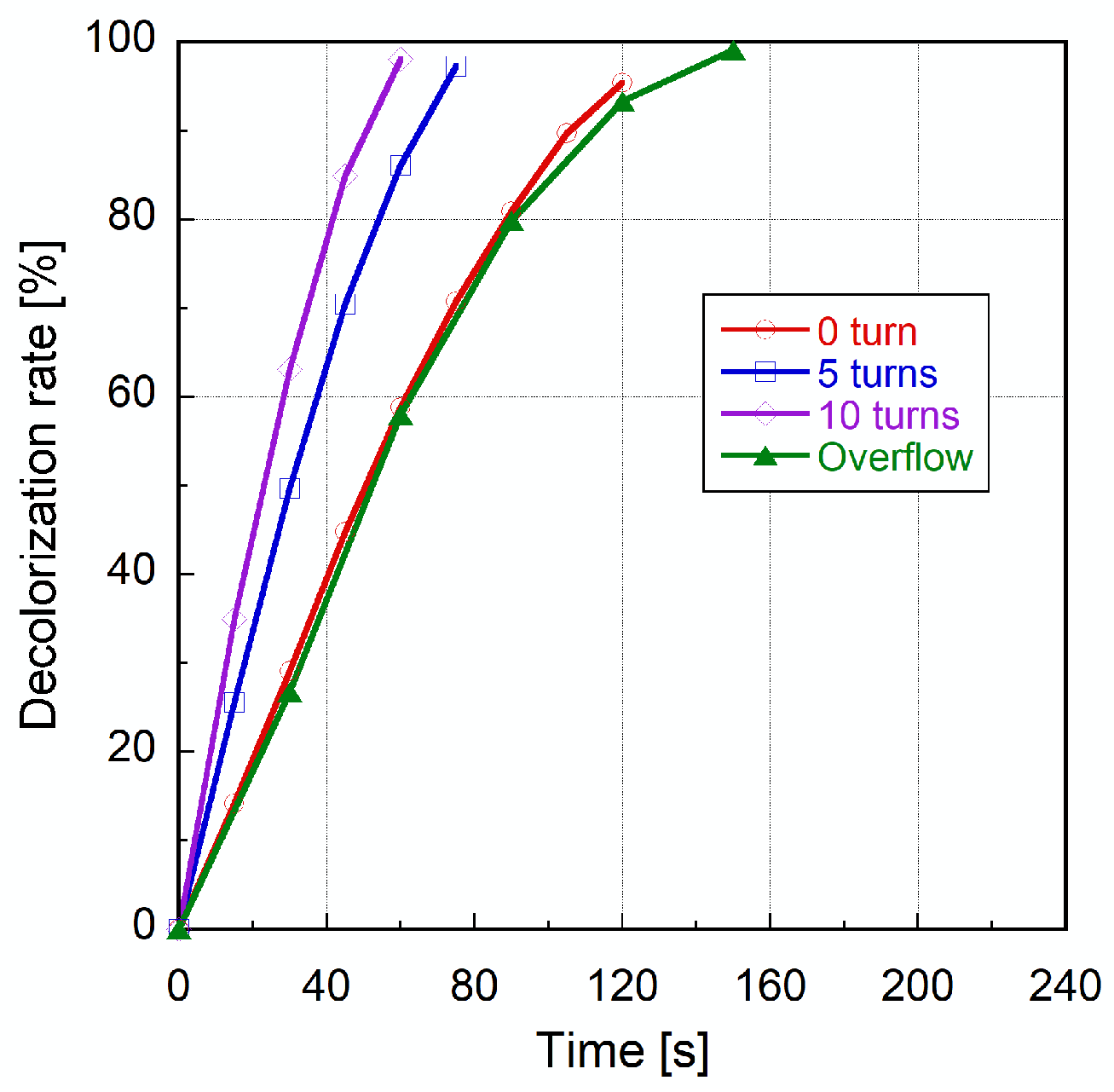
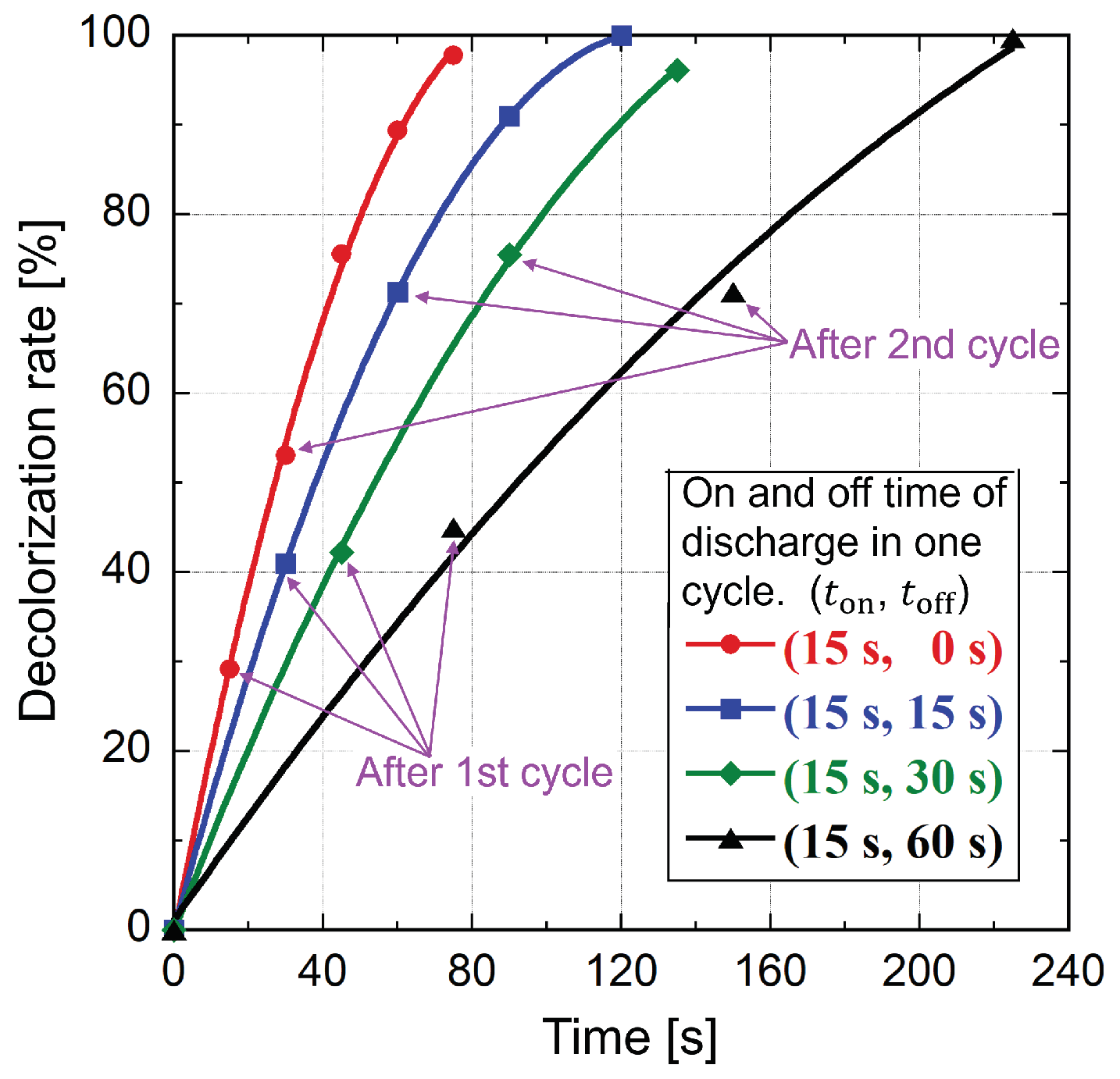

Publisher’s Note: MDPI stays neutral with regard to jurisdictional claims in published maps and institutional affiliations. |
© 2022 by the authors. Licensee MDPI, Basel, Switzerland. This article is an open access article distributed under the terms and conditions of the Creative Commons Attribution (CC BY) license (https://creativecommons.org/licenses/by/4.0/).
Share and Cite
Tachibana, K.; Hanabata, R.; Furuki, T.; Ichiki, R.; Kanazawa, S.; Kocik, M. Development and Evaluation of Newly Designed Coaxial Cylindrical Plasma Reactor with Liquid Flow Control and Post-Discharge Reactions for Water Treatment. Energies 2022, 15, 4028. https://doi.org/10.3390/en15114028
Tachibana K, Hanabata R, Furuki T, Ichiki R, Kanazawa S, Kocik M. Development and Evaluation of Newly Designed Coaxial Cylindrical Plasma Reactor with Liquid Flow Control and Post-Discharge Reactions for Water Treatment. Energies. 2022; 15(11):4028. https://doi.org/10.3390/en15114028
Chicago/Turabian StyleTachibana, Kosuke, Ryosuke Hanabata, Takashi Furuki, Ryuta Ichiki, Seiji Kanazawa, and Marek Kocik. 2022. "Development and Evaluation of Newly Designed Coaxial Cylindrical Plasma Reactor with Liquid Flow Control and Post-Discharge Reactions for Water Treatment" Energies 15, no. 11: 4028. https://doi.org/10.3390/en15114028





